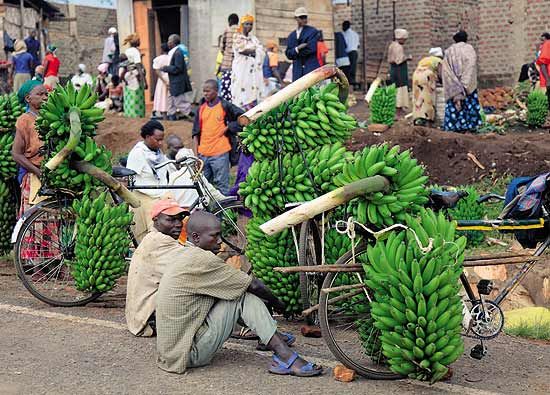
The bacterial disease Xanthomonas wilt causes banana fruit to rot © Pascale Lepoint / Bioversity International
Dr. Fen Beed is an experienced plant pathologist based at the International Institute of Tropical Agriculture (IITA), Dar es Salaam, Tanzania. He leads research for development activities to mitigate the impact of diseases of maize, soybean, cowpea, cassava, banana and vegetables and promotes plant diseases on problematic weeds.
The first and critical step to manage a disease is to diagnose the causal agent(s). Once this is done, appropriate control methods can be deployed, based on available knowledge or on results generated from targeted research. IITA led an initiative to define the factors required to create a functioning disease surveillance network across a region.
The initiative targeted the two most serious threats to banana in the Great Lakes region of sub-Saharan Africa (SSA); namely banana Xanthomonas wilt (BXW), caused by the bacterium Xanthomonas campestris pv. musacearum (Xcm), and banana bunchy top disease (BBTD), caused by the banana bunchy top virus (BBTV). BXW and BBTD are established in several countries in SSA where banana production is of critical importance. Countries included were Burundi, Democratic Republic of Congo (DRC), Kenya, Rwanda, Tanzania, Uganda and Zambia. In order, to strengthen both national and regional communication pathways, representatives from both national research organisations and national plant protection organisations agreed to form a network for regional surveillance of BXW and BBTD. The specific objectives were to share information on the diagnosis and management of these diseases and to map their distribution across locations that were of strategic importance to the region.

Results of DNA tests for presence or absence of BBTD disease can be plotted onto clear GIS maps © IITA
During an inception meeting in Rwanda the network reached consensus on where to prioritize nationally-implemented disease surveys, based on a combination of both national and regional needs. The zones selected for surveys tended to be close to country borders or where the presence of disease(s) was unknown, but where invasion risk was high due to close proximity to areas with disease or areas where disease outbreaks had been reported but not confirmed. Each disease survey was planned to ensure sites to be visited were spatially representative and not clustered. Global positioning system (GPS) units were used to facilitate navigation, to make return visits to interesting findings possible and to allow for the development of maps using a geographical information system (GIS).
National staff performed surveys during 2010 and recorded at each site the presence or absence of characteristic disease symptoms of BXW and BBTD. In addition, at each field survey site, samples of pathogen DNA were collected from the plants assessed visually for disease symptoms, using novel DNA capture kits. Analysis of DNA capture kits was performed under laboratory conditions using polymerase chain reaction (PCR) based molecular diagnostics and primers specifically designed for detection of Xcm and BBTV. All DNA capture kits were analysed at the regional laboratory of the National Banana Research Programme of the National Agricultural Research Organisation (NARO) in Kampala, Uganda. A benefit of using DNA capture kits for centralised PCR-based diagnostics was that samples obtained from across the region could be stored for up to six months and analysed using uniform methods, staff and equipment on the same date(s) in order to generate comparable results.
Results from regional surveillance activities were plotted on a visually easy-to-interpret map that can be instantly shared across research staff and regulatory officials and updated with new information as it becomes available. Common knowledge and increased awareness of the distribution and impact of a disease is important in order to target where to deploy management strategies to prevent further spread.
1 Comment
Leave a Reply
Related News & Blogs
Three policy recommendations to reduce pesticide risk
Farmer spraying pesticide in Nakuru, Kenya CIMMYT/Peter Lowe (CC BY-NC 2.0) Pesticides can provide rapid means of controlling pests and prevent crop losses, but they can also pose a major risk to humans, animals and the environment. A recent research p…
28 October 2021





Thanks this really helps